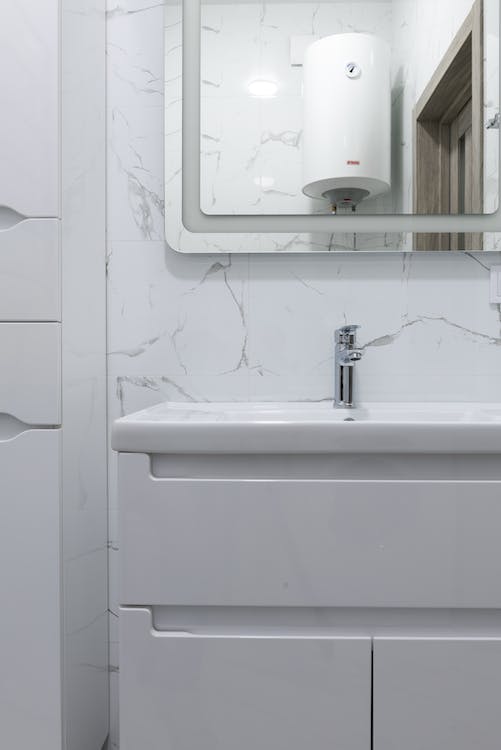While home heating and cooling are the biggest culprits behind hefty energy bills, they are the best places to look for cost-cutting opportunities. As a homeowner, you may look into more long-term energy-saving ideas like insulation, double glazing, or maybe even a carbon-neutral heating system. However, if large-scale energy-saving projects are currently out of reach, rest assured that you don’t require a significant home improvement project to enjoy considerable annual savings.
Want to reduce your utility bills? Follow these ten tried and tested ways to reduce water heating costs at home.
Table of Contents
1. Tweak Your Tank’s Thermostat
Ready to save energy and reduce utility bills? Try lowering the temperature of the thermostat on your water heater.
Did you know that by reducing your thermostat’s temperature by 20 degrees, you can cut the water heater’s energy consumption by up to 10%? When you consider that heating water accounts for up to 25% of the total energy usage in most American households, it’s easy to see how lowering the temperature can provide significant cost savings.
2. Fix Leaky Faucets
Even if you own the most efficient hot water system, you will still waste water and pay hefty bills if your faucets leak. You can significantly reduce your hot water use by repairing leaky faucets. A leak of one drip per second wastes 1,661 gallons of water and can cost up to $35 per year.
3. Go Low-Flow
While relatively inexpensive to replace, aerators can be one of the most cost-effective water conservation measures. For maximum water efficiency, purchase aerators with a flow rate of no more than 1.0 GPM. Some aerators even come with shutoff valves that allow you to stop water flow without affecting the temperature.
4. Take Shorter Showers
Taking shorter showers is an easy and effective way to save water and energy bills. A regular 10-minute shower on a 2.5 gallon per minute showerhead uses 25 gallons of water. You could slice your hot water demand to only 12.5 gallons of water, shortening your shower by half.
5. Drain the Sediment From Your Tank
Over time, sediment in the water settles to the bottom of your water heater tank, affecting the efficiency of your water heater. Ensure that you call a professional to drain sediment off your water heater at least once a year. If you have some DIY skills, you can consider doing it yourself.
Here’s a step-by-step guide on how to flush sediment out of a water heater:
- Turn the heater off
- Turn the cold water valve off
- Attach a hose to your hot water tank’s drain valve
- Place the end of the hose in a bucket or drain.
- Turn on the water from any hot water faucet in your house to release pressure in the water heater. Leave it running until you finish this DIY water heater maintenance project
- Drain the tank of water with sediment.
6. Install a Hot Water Heater Timer
Your water heater consumes energy even when you are not using hot water if it’s connected to a power supply. Adding a timer to your water heater can be very beneficial, as it saves you a lot of money on your electric and water expenses.
A water heater timer essentially allows you, the homeowner, to determine when your water heaters will function, depending on when your household requires hot water. A water heater timer is a must have for families with relatively stable schedules.
7. Insulate Exposed Hot Water Pipes
Did you know that your water heater is always set at a higher temperature than you need? It is because your hot water needs to travel a certain distance from your water heater to your taps. If your hot water pipes aren’t insulated, you must set your hot water thermostat even higher, which translates to hefty power bills.
Insulating your hot water pipes is a relatively simple undertaking with significant results, assuming you have easy access to the pipes. We recommend you hire a certified heating company for the task if you aren’t confident in your DIY insulation skills.
8. Insulate Your Water Heater
Is your storage-type water heater warm to the touch? If your answer is yes, you should consider insulating your water heater. Water heater insulation has the potential to reduce standby heat losses by 25%–45% and save you about 7%–16% in water heating costs when done right.
Don’t worry about hiring a pro to insulate your water heater, as the project should pay for itself in about a year.
9. Install Heat Traps on Your Water Tank
If you have an electric or gas water heater, it is imperative to have heat traps on the water heater. Heat traps allow water to flow into the tank while simultaneously preventing unwanted hot-water flow out of the tank. Heat traps are fundamental in reducing heat loss by up to 60% as they effectively stop convection and avoid heat loss through the inlet and outlet pipes.
10. Replace Old Appliances
The highest cost of washing dishes and clothes comes from the energy required to heat the water. If your washing machine or dishwasher is over ten years old, consider replacing it with a newer, more energy-efficient model. Plenty of new designs on the market use less water and are much more energy efficient than what was on the market ten years ago. You’ll significantly reduce energy costs by purchasing and using an ENERGY STAR-certified dishwasher and washing machine.
Summing Up
Remember that conventional tank water heaters last 15 years on average. If your heater is coming to the end of its life, consider replacing it with a more efficient unit, such as a tankless water heater.
If you are ever in need of quality plumbing services, Gallegos Plumbing has you covered. From routine drain cleaning to malfunctioning water heaters and emergency plumbing services, our highly-trained plumbers have seen it all! Call (805) 750-1830 or visit our website for more information!













